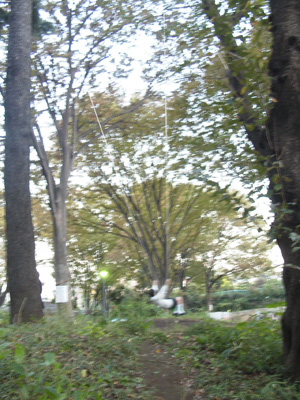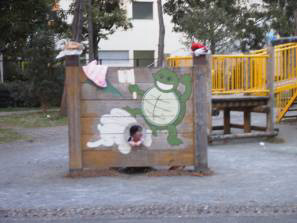どのようにして我々のウェブサイトを読んだら、あなたはよりそれを楽しめるか、それを言うのが先決なのだろうが、正直なところ今それに取りかかるのは大変難しい。少し時間が必要である。だから、先ずは、いかにしたら都市を楽しめるかを述べてみたいと思う。都市の鑑賞法とでも言おうか。現実の都市、それが東京の如き巨大都市だろうが、地方の小都市でも変わりなく楽しむ方法がある。先ず第一に都市を美術館や劇場として視る視線を持つ事。現実の都市はあらゆる芸術、演劇、フィクションよりも複雑で衝撃的なマテリアルに満ちた世界にすでに入り込んでいる。その事を頭脳にしっかり枠付けて都市を眺めると、そこに少し違う風景が浮かんでくるのを知るだろう。
第二に目で見る前に、知覚で触れる努力をする事。この方法は簡単なので、事例を挙げながら、さっそく試みてみよう。
公園は異物、異形の蠢く密林である - 戸山プレイパーク
研究室を一歩外に出てみる。ここは戸山公園だ。そこは東京でも有数なホームレスピープルの集落があり、得体の知れぬ体育施設もあり、そして日本有数のプレイパークだってある。そこをグルリと一巡してみると公園には現代の不可思議さが充満しているのがすぐに知れる。不思議といっても、不思議大好きの薄っぺらい風景ではない。不思議の国のアリスそのマンマの世界。ナンセンスで飛んでもハップンで、とてつもなく、お下品で、同時に十分に人間の善意やらに、まだまだ満ち溢れてもいる世界が繰り拡げられている。奇妙な不気味でナンセンスなモノその風景は我同行の若者達の案内に任せるとして、私の都市の始まりは、とっても良い風景の紹介から始めたい。都市には、こんな新種のメディア化したと言っても良いユートピア劇場が厳然としてある事を初めの一歩としたいのだ。
戸山公園の西南の隅に、東京で一番のブランコがある。それはロープで高い樹木から吊り下げられただけの手作りのブランコだ。何故、東京で一番かと言えば他にはありようがないスタイルを持つからだ。つまり東京には、ひとつしかないのだから、当然一番でしかあり得ないのである。公園という、ありとあらゆる場所は役所の管理下にある。戸山公園は新宿区役所の管理下にある。その事を考えると、このブランコの出現は殆ど奇跡に近い出来事なのである。役所はその管理下の場所での事故を恐れる。特に役所が設置した物による事故を恐れる。恐れて止まない。ところがこのブランコは誰が考えてみても危なそうに見える。高い樹木に結びつけられただけだから、先ずそのその枝が折れたらどうらぬか、又ロープが切れたらどうか、あるいは余りにも長く揺れるブランコだから、そこから落ちたらどうかという様な心配は絶えぬだろう。公園の中の公的な遊具としてはあり得ない物体である。何故こんな異形が公園内に出現したのだろうか。明らかに人間の手作りの、非工業化、非標準化の象徴物でもあるモノが、公的なフィールドに出現し、子供達がそれを現に自由に使用して、楽しんでいる。
実ワ、このブランコのある場所は新宿・戸山プレイパークと呼ばれる特別な場所だ。
一九九八年、この公園近くに住む親子五組が外の、ささやかな自然の中で子供を遊ばせたいと、水曜日の午後に子供の広場で親子で共同で遊び始めたのがそもそもの始まりだった。近くの人々の自主運営が基盤となり、役所が次第にそれに協力するという形となり、二〇〇六年の四月に、日曜日、月曜日を除く、週五日間連続開催の新宿・戸山プレイパークとなった。現在(二〇〇六年)日本各地にひろがるプレイパークは約二〇〇ヶ所ある。そして、週五日も開催されているのは二〇箇所程度であるようだ。戸山プレイパークはその一つである。戸山プレイパークにはプレイリーダーと呼ばれる専従の人間三名が有給で働いている。少なからぬ数の市民団体のボランティア活動によって支えられている。しかし、始まりは近くの数名の親達が子供を外で遊ばせたいと言う意志(愛情)であった。
すでに都市の現実は子供を野放し状態に出来る程、自由で安全な状態にはない。子供達にこのブランコのようなある種の野性味を体験させるのには、かなりの分厚い監視システムが必要なのだ。
この大きく、のびのびとしたブランコは、だから大人達の監視下に置かれた大きな劇場の舞台装置なのである。今では公園も又、劇場なのだ。
プレイパークは子供が野生らしきを演じる劇場である。大人達はそれを支える裏方、黒衣であろう。観客は、それを相互に演じ分ける子供と、大人の双方だろうか。プレイパークの子供達は子供らしく遊ぶ子供役をすでにその本能で演じている異形なのだ。子供達の身体能力は多くの点で劣化しているだろうに違いない。外で遊ぶ事が不可能になり、TVやコンピューター、メディアの中で遊び暮す事が多くなった彼等は、すでに昔の子供ではない。モンスターなのである。かつて夜は千の眼を持っていた。それは夜の闇の内に羽ばたく想像力の多様豊穣を意味していた。今、都市に夜は訪れない。闇は失せた。そして公園は千の眼を持つ場所になった。その眼の中で子供は子供らしさを演じる迄に進化している。
Blue Tarpaulin : ヨハネス・ケトラ
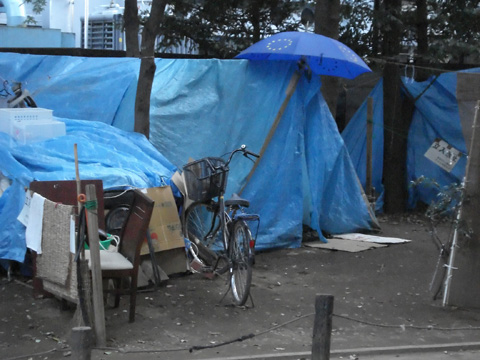
The men and women living under the blue tarps of Tokyo are homeless. Most of them lost work, shelter and the social environment all at once, not to mention the loss of status in Japanese society. In Japan homelessness is rarely the consequence of drug abuse ore other selfdestructing processes but mostly the result of a rapid economical downfall. For the affected persons this often means a sudden decreasement of living conditions. Sometimes they directly swap from the world of the black suit businessman into the life on the street. This is an explanation for their attempt to keep the living standards even there as high as possible. Two-thirds of the Japanese homeless are willed to work again and many of them are much more intellectual and educated as the society supposes them to be. But the biggest obstacle on the way to rehabilitation is the Japanese society itself, which usually tends to segregate the socially disadvantaged. Once the homeless people lost their reputation it can hardly be restored and the hope for a re-entry into the ordinary life disappears. There is improvement in Japanese law since 1999, but still the social support lacks.The homeless people react in generating own social structures and mutual aid. In this sense also their architecture, a paradox in terms of homelessness, seems now to be an icon of the unsheltered life. It is cheap and mobile and hence reduced to a minimum. A collage of materials like Paper, steel structure, timber and findings. However, the top layer always consists of the same material, a blue tarp which is combined to a multilayered waterproof skin. Beneath its functionality this material has become a symbol of homelessness itself, covering Tokyos parks.
In Shinjukus Toyama park there was an interesting shift in detail of one tent. It was marked with an umbrella in the blue colour of the European Union, showing the stars of the European flag. There is no evidence why the owner chose this symbolic umbrella to cover his house, probably it's just a coincidence. But it leads to some thoughts. Though the European Union was built on an economical foundation, it has become more and more a cultural union. Like the community of the homeless it has also a protective function and like the community of the homeless it was based upon a sad event, in the European case the First and Second Worldwar. Both systems are based on a lack of social and economical power. Considering nowadays situation in East Asia we should think about how a cultural and protective union could be built without that tragic event that connected the people in Europe and in Toyama Park.
戸山公園のイソップ童話「うさぎとかめ」と子どもたち:渡邊大志
「自らの油断の為にかめに敗れたとはいえ、なぜ勝ち誇ったかめに足蹴にされているうさぎの方に子どもが顔をはめるのか?」という極めて単純な疑問が浮かぶ。私は中学からこの近辺に通っていたのでもう10年以上も戸山公園周辺をうろうろしていることになる。その間、ずっと不思議に思いながらもやり過ごしてきたのが、戸山公園の出入り口にあるこの遊具だ。
「うさぎとかめ」はイソップによって紀元前600年頃に書かれた童話である。決して油断をしてはいけない、かめのように努力を続けなければならないという教訓なのか、背景を調べてみる事にした。調べてみると、次の様なことがわかった。設置されたのは平成四年であり、この遊具はメーカーで大量生産されて流通しているものである。公園を管轄している東部公園緑地事務所に問い合わせてみると既に資料がないためメーカーの特定はできなかったものの、できるだけ子どもたちになじみ深く、広く知られているものが良いということでこの遊具の購入が決定されたという。また、戸山公園の一部はかつて日本初の交通公園であり、大人が子どもたちに交通規則を教える教育の場であった。そのため、のろまなかめがスピードにのぼせたうさぎに勝つというストーリーが好まれたのかもしれない。さらに言えば、距離が消滅した情報社会に生きざるを得ない我々の時代に、流行としてのスローライフが囁かれるようなこと自体が幼い頃のこういうストーリーの記憶によるものだろうか。
ついついいろいろ考えてしまうが、穴からのぞく子どもはどうやらそのような大人社会の事情にはおかまいなしのようだ。子どもは大人たちのデザインや遊具に描かれたストーリーとは別の世界で今、ここにいる。現実そのものがつかの間の遊戯性を帯びて子どもたちの「今、ここ」という物語が展開されている。アリスが迷い込んだ不思議の国が2006年の東京の子どもの頭の中にある。
大人のへりくつが現実に生み出した妙な気配:丹羽太一
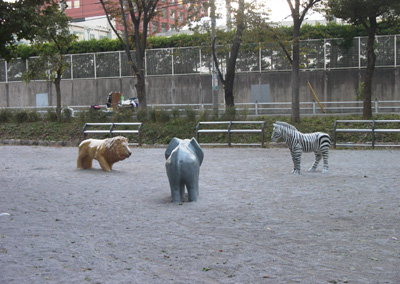
戸山公園は 1954 年に開園、当初はゴーカートもある遊園地のような交通公園でしたが、70年代に近隣の住宅が高層化し、今の運動公園に変わったようです。
戸山交通公園にはライオンとシマウマと象と虎、4つの小さな動物型遊具がありました。公園の改修に伴い一度はとりはずされはしたものの、どういった経緯があったか、これをそのまま廃棄するのは能がない。新しい公園に再びおくことにしよう、ということになったのです。西側の一角の遊具コーナーを設けるのでそこに他の運動遊具と一緒にひとまとめにおくことになりました。こうした遊具はそれぞれに子供が乗ったときにお互いが向き合うように配置するものなのでしょう、ライオンとキリンと象と虎をこう向かい合わせて・・・ところがそこで誰かが気付いたのです。ここに虎がいるのはどうもおかしいと。ライオンとシマウマと象はもともとアフリカの草原にいるものだからこの砂地にこうしていても自然だが、虎というのはユーラシアのジャングルにいるものだからここに一緒にいたらちょっと腑に落ちないじゃないか。ここは子供にも誤った知識を与えないよう、虎は虎が本来いそうなところに、こうもっと鬱蒼としたところに隠れるようにおいてある方がいいにちがいない。そうだな前門の虎なんてこともいうからこちらのゲートにこう向けて・・・
公園の明治通りからの入口を入るとすぐ、ちょっと古くさい虎が突然にひっそりと、なぜか目立たないこんな場所にこうして一つだけおかれているのです。
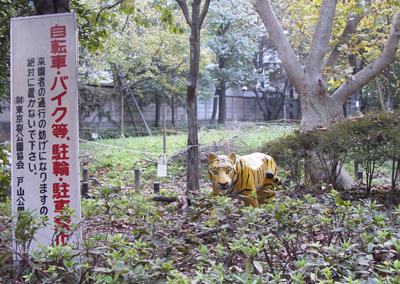
bent jungle and serialized nature : Kai Beck
We left the city and entered the Toyama park nearby the laboratory. It seemed to be an oasis of the naturalness. A place to enjoy and relax from the stress of the everydaylife of the city. The Nature is here, at least a little bit.
We can see the trees, the bushes and hedges.
We can hear the sounds of wind, birds and some people walking on the sand.
We can smell the flowers, the grass and the wood.
We can feel the nature in its place...
Something strange, not everything seemed to look as peaceful. What is it?
If we take a closer look, we can see the appearence of steel in the the dress of cutted wood. In other sites, for example in Nikko, one of the treasures of japanese culture, we can have an experience with plastic-wood by walking on it, in the middle of the world heritage.What is it, that makes us produce such strange imitations of nature?
Can it be cheaper than reality? If we think about the restrictions of the material itself we can come to the point, that wood can be grown, but plastic or steel is in the touch of an industrial process with a limited use and a much more long timespan in entering the natural cycle. Is this a possibility of the past, the present or even the future?Even the haptical appearence of the copied material is far from being nice.
I have to admit the copy is good and it looks on first sight as the original, but this is something which makes it just more untrustable. In our thinking it is enough to let things look like a feeling. In the age of modernity we started to use industrialized products and increased the number into endlessness, but now, for the 21st century i would like to ask, if we not have to come back, closer to nature and use the industrialization where it is a need and useful. Possibly we went one step too far.The reality wears a costume and this is the ridiculous, but demoniacal one of a harlequin.

Among the twilight of modernity : Kai Beck
On the edge of Toyama park we stepped in the housing and commercial area in the range of Takadanobaba station. The first building we met is a 12 floor dwelling house. A concrete building, maybe built in the 70s or 80s. The first floor of the street facade is filled with shops and restaurants. In this time of the day, the shops already put on the luminous advertising.
Inbetween these we can find an unlighted place. The appearance is strange, it is a usual window of the area, closed with a blue curtain and above is a wooden plate with small letters telling us °Rudolf Steiner Haus Japan°. A little postbox and some posters as a sign of motion.The place seemed to be strange, in the middle of somewhere, in any faceless building of the last century, if we compare to the Goetheanum in Dornach/ Switzerland. Does it fit the keypoints of Steiners teachings, the antroposophical tenet?
Our first walk came to my mind and i remember two of the child teachers of the °Abenteuerspielplatz° in Toyama park told me about a trip to Germany to study about the concept of Rudolf Steiner schools and the idea of Kindergarten.
After coming back to laboratory i found the homepage of the Antroposphical society and i could read about the global network of the houses. Like in Takadanobaba it exists in more than 78 other countries, with the mainbase or °soul° in Dornach. By e-mail i asked about the work of the society in Japan. No answer yet, so the motion seemed to be very slow.
Mainly the work is to organise workshops, including art and theory.After thinking about the situation of the house in Japan and rereading some texts by Steiner himself, i still wonder about his sofisticated idea in the early 20th century. Within the progressive Industrialisation, the orientation and the significance of life came more and more to the individual person. Entirely our existence arrived at ourself.
Maybe it is a good point to set the stage of the theory of philosophy, art and paedagogy, based on the human being itself [antroposophical theory], in the center of dusty capitalism, the twilight of modernity as a result of growing economy. The Steiner Haus and its surrounding seemed to be in antagonism, but in my opinion they are mutually dependent.

1.5 million vending machines and 50 lemons a day : ヨハネス・ケトラ
In Tokyo vending machines on every corner are already taken for granted. But despite their functional aspect, they include as well some interesting comments on contemporary Tokyo and its achievement-orientated society.Every single vending machine with its own special range of beverages is an autonomous object, run by several different companies. But in the density of their appearance, a network forms that overlays the single object. There is a big difference in comparing it to the historical concept of a marketplace. Where in the past the action of buying was linked to a dedicated place, now it doesnヤt matter where you are situated. Moving through the streets of Tokyo be sure to discover vending machines everywhere you expect them to be. Within this non-hierarchical horizontal netting lies also a connection to our information society. Information is available almost everywhere. To achieve this, apparently the media changed. The media, that can be as well architecture, the inhabitants or a vending machine. As networks always implie a widespread distribution of nodes, serialization is obvious. In Tokyo you can feel the networks as much as the resulting serialization. For the complexity of a city like this, the concept of decentralized networks emerged as the most suitable. You can see similarities in the decentralized urban plan of Tokyo or the system of Koban and adresses.
Nowadays we should ask ourselves how the sorrounding networks take influence on us and how we can avoid the serialization within this systems of nodes.To be unique the recent vending machines follow the concept of "more is more". Bright lightened they are noticeably praising themselves with extra advertisement for the drink of the week. In the night you can see the buttons blinking to the rhythm of an inaudible beat. Itヤs a factoid individuality of a superficial surface, which is addressing the common people of a highly competitive society. Hence the bigger part of the sold beverages are coffees and artificial energydrinks with lots of added vitamins. Like paying a coin for an Omikuji-paper at a temple or in a coffee house, people are used to the little efforts in life you can achieve with a small amount of money. But who needs the vitamin c amount of 50 lemons a day? And more important, what was first? The vending machine or me, throwing the coins? In the end with a 24h-vending machine around every corner, at least there is no excuse to be ever weak or tired again.
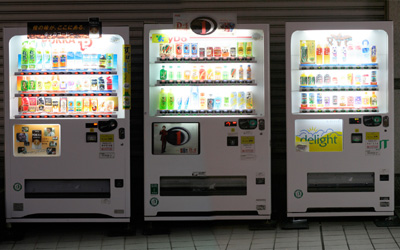
The dark side of the network : Abel Erazo
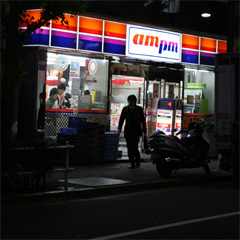
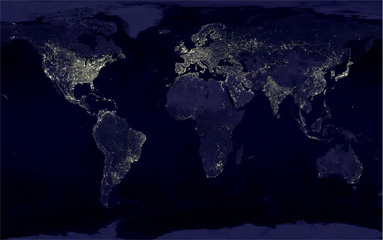
One month ago I had to travel for a couple of weeks to South America, Chile. Coming from Tokio it was very clear the difference about the energy consume. Our Latin American cities works in the night with half consume of light if we compare with the cities of the 1st world. In Santiago I had the impression that the environment was a mixture between urban and countryside. The city escape in the night was weak and fragile.
I think that the definition of a metropolis is not only about infrastructure, accessibility or connectivity to the physical networks. The scale of a metropolis is possible to be measure also by メthe incandescence of the night escapeモ. In the night, a city without light it doesnユt exist.
In the airplane over Phnom Penh it looked like no light in the ground, remembering the ghost aspect of 30 years ago. However in its streets I could feel a strange and powerful energy. Everything was active there in the darkness. When we take a walk is possible to find smalls shops which open 24 hours like the Tokioユs convenience stores, but in the darkness....
The convenience store had became a symbol not only of the fast consume in the stressful urban life of the modern world, but also as a terminal connection with the global information network, in the physical level and the virtual one.
境界のかたちについて:渡邊大志
以前、唐十郎の紅テントに『カーテン』という演目を見に行ったことがあった。廃校の様な小学校の理科室の窓にかけられたぼろ布の様なカーテンの向こうからあらゆる虚構が魑魅魍魎の如くにやってきて現実と入り交じり、またカーテンの向こうへと帰っていくというシナリオなのだが、そのとき舞台裏のテントが突然外されて、実はカーテンの向こうは我々がいる本当の現実空間であったという、虚構と現実が二重の入れ子状に描かれているものであった。
それを見た時にふと頭に浮かんだのが日本の神社の回廊である。その出入り口にはまさしくカーテンとも言うべき布がかけられ、聖と俗をわけているわけであるが、興味深いのは唐のカーテンも、神社のそれも風で揺れる性質を持っている事である。つまり境界は曖昧であり、カーテン状の布は柔らかい門である。さらに、伊勢神宮や諏訪大社を考えてみると、神社の紋が描かれた布は門であると同時にその向こうの景色を視線から隠すために掛けられている様にも見える。神社の本殿が倉庫の性質を持つ事は磯崎新の『伊勢』などによって既に知られているが、倉庫の中にある聖を隠す役割がここにもあり、柔らかい境界は風で揺れてちらちらとそれを我々に見せるさまは官能的ですらある。
唐は神社に見られるような境界の構造は我々の日常に溶け込んだ文化であることを示したわけだが、それは我々の研究室の周りでもみることができる。
研究室から新大久保駅へ向かう途中に台湾風のヴィラがある。この辺りは前回紹介した戸山公園の地域から大久保通りにぶつかるまで何本もの露地が300メートル程、直線状に伸びている。その露地をずっと歩いて、大久保通りにぶつかる直前の脇道を左に折れると、民家や小さな作業所が並んでいて、目線を前にやると、さらにその先に小道があることがうかがえる。この時点で既にどこか違った世界に迷い込んだような心持ちがするのだが、先の小道へ入っていくとそこにある古いアパートの一室のドアが開け放たれている。ドアの上には「白宮」の文字があり、中には真っ赤な色で彩られたいくつかの祭壇らしきものと、その上には「百玄宮」の文字がある。夜の黄昏時に訪れるそこはもはや虚構世界の塊のような場所である。唐が演劇という形式を借りて描いた世界がそのままそこに現れたような気がした。この台湾風のヴィラは300メートルの露地をいわば参道としている。そのパースペクティブの効いた奥行き感こそがこのヴィラの虚構世界とこちらの境界であり、さらにそこから脇道へと誘導していくことで虚構世界へのいざないは決定的なものとなる。
また、研究室からそれとは反対の高田馬場駅方面へと歩いてみても、教会が一つある。この教会は外から見ると和風民家にプレートがつけられただけのもので、先ほどの台湾風のヴィラと違って扉は難く閉ざされたままである。ここが一体何教の教会なのかはわからないが、扉が閉じられているのはこの教会が高田馬場駅へと続く大通り沿いに建てられているからであろう。台湾風のヴィラの様に奥行きを使った境界や、伊勢や諏訪のように森の中にあるわけでもないために柔らかい境界を物理的に形成することは困難である。そのため、扉が閉ざされたままなのだが、実は住宅であれば玄関と呼ばれる部分へ行く為には歩道から石段を三段上がらねばならない。この三段の石段こそがこの教会の内部に隠された虚構を守るために成し得た精一杯の抵抗の様に見えてならない。
伊勢や諏訪に限らず、いかなる教会やヴィラ、あるいはその内に虚構を隠し持った倉庫と呼ばれるものは何らかの境界のかたちを現実世界へ示さねばならない宿命を持つのである。
駅前広場に民集えども:丹羽太一
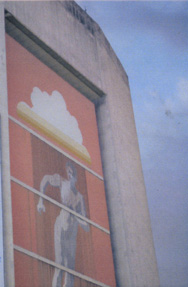
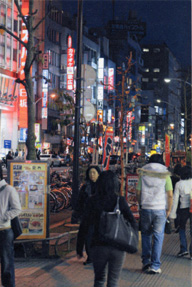
古い歴史を持つ都市には昔から、その時代時代の中心の役目をもつ広場がある。新しい都市では時にそれが都市計画的につくられる。でも東京には、公園はあっても歴史という長いスパンで役目を持ち続けてきたような広場はない。近代の発展という小さな歴史のなかでかろうじてできた駅前の広場はそれでも、現代の都市生活の広場なのかも知れない。
駅前広場は文字通り鉄道の駅の前、交通の節点につくられた広場であるから、それは交通起源の広場だ。つまり古い広場にあったはずの政治も宗教も生活もない。今では周りを囲む建物は行き交う人々を誘う消費の回廊の雑然のみの、まるで近代都市東京の無機空間ができあがる。
高田馬場駅前にあるBIGBOXは 1974 年にスポーツレクリエーション・商業施設として建てられた。今は高田馬場駅で学生の待ち合わせ場所の定番になっている。夕暮れ時にBIGBOXを目印に集まってくる学生の目的は大抵は宴会、しかもBIGBOXのある駅前広場は交通の広場。交通の広場では人は交通を共有するのであるから、駅前広場は宴会のための集合場所になるだけで、待ち合わせができれば皆次の目的地へ移動していくのが常である。必然、BIGBOXはその交通の通過点として見上げられるばかりになる。待ち合わせの目印として広場に対するひとつの役目を担ってはいるが、目印であるから実はその中身は広場となんの関係もなくていいのだ。だからBIGBOXは中身と外見が乖離している。BIGBOXはスポーツ施設だから、見上げられた広場正面には大きな走る人の壁画が描かれているのだけれど、日々、通り過ぎる人々の頭上でそれは虚空を駆けて、やがて夕闇に消えていく。
都市の楽しみ方:石山修武
ようやく高田馬場駅前迄たどり着いた。外国人も混じえた小旅行だったので普段見過ごしていたもの迄眼に飛び込んでくるのだった。独人で歩くのと、同行者が居るのとでは世界が違って視える。ましてや、野郎ばかりだけれどドイツ人、チリ人等と共に歩くと景色に何故か時差の如きが発生する。彼等の眼には私が積まらぬものと通り過ぎているものが、通り過ぎるわけにはゆかぬものとして写っているのが解る。
江戸、深川の幻庵を奥の細道へと出立した俳人芭蕉にも曽良という同行者がいた。芭蕉にはどうしても同行者が必要だった。長旅の心細さばかりの理由ではあるまい。五七五の定型短詩の表現者であった芭蕉にはどうしても観客としての同行者が必要だった。ほとんど独人言に近い俳句という言葉の表現、そのつぶやきを、独人で続けるのには無理がある。独白を型にはめ、なおかつ記録に残そうとするには、どうしても観客が必要だった。当時すでに俳句は連句その他の同好の士の集団が各地に生まれていた。今に例えれば、俳句は“おたく”の同好会であった。五七五のつぶやきを評価し合う仲間があって、初めて成立した世界である。引籠もりクラブと何の変わりがあろうか。芭蕉の旅もそういう各地に点在し始めていた同好者のネットワーク、すなわちバラバラな集りを訪ね歩く旅でもあった。その仲間内の会でのプレゼンテーションを最大級の楽しみにしていたに違いない。マ、知的カラオケ大会みたいなものだった。
五七五だけの言葉の連なり、その組合わせを楽しむのには、どうしても優劣の区別が必要になる。何故なら、それは殆んど誰でもが出来る世界であったから。そこに出来、不出来のグレードを設けなければ成立しない世界であった。ある意味では評価の妙、クリティークの妙こそが問われる世界でもあった。小さく特化された集団内での独特な評価の競い合い。まさに“おたく”の世界である。旅は日常生活からの離脱を旨としてなされる。しかし、よくよく考えてみるならば、独人旅は日常の延長でしかない。日常とは独人の連続であるから。あるいは、それは現代の特色なのかも知れない。心揺れる他者との交換作業が乏しいのが現代の特色でもあるのだろう。
前近代を生きた芭蕉はその事を良く知っていた近代的人間、表現者であった。江戸深川に居る時の芭蕉は本当にただの“おたく”人間だったろう。だって、考えて見たまえ。
蛙とびこむ 水の音
アッという間の思いつき、つぶやきを得て、これはイケるぞと得意になり、前に付け加えるべき句にアーダ、コーダと四苦八苦する、そんな人種は完全に周りの町民からは孤立していたに違いないのだ。
それで、芭蕉が類いまれなのは仲間を組織したことだ。その仲間内での評価、クリティークに明け暮れしようと試みた。しかしながら小さな仲間内での会の連続には限りがある。要するに観客、サポーターがずーっと同じ人という日常にまみれてしまい易いから。
であるから、芭蕉は旅に出る必要があった。自分の作り出した俳句劇場内自己演技を、更により劇的なものへとグレードアップさせる為に。旅は芭蕉にとってモバイルする劇場であった。
曽良はモバイル劇場の貴重な観客であった。今という時代から眺めてみれば、芭蕉よりも不可思議な人種であったやも知れぬ。旅に同行して、芭蕉よりも常に格下の句作にふけるのを日常とした。だって芭蕉よりも良い句を詠んでしまったら、観客が演者よりも卓抜な表現をしてしまったら、俳句劇場のシステムが破壊されてしまうからだ。都市の楽しみ方、それは日常生活を穏やかに劇場化する事である。そして都市の観客としての我々が演者としての都市の現実を喰ってしまう、そんな遊びを試みる事でもあろう。
我々の中に芭蕉はいらない。あんな変テコリンな才も必要ない。ただ、ただ、短いクリティークを続ける事で、観客としての我々が同時に舞台上に在る事を時々自覚すれば良い。
さて、高田馬場駅からグルグル輪廻の山の手ラインに乗って、奥の細道ならぬ、ただの細道の旅に出よう。遠くにゆくばかりが旅ではない。しかし、室や家や、いつもの処に引きこもっていて、それで楽しめる程に我々の想像力はジャンプも、ダイブもしにくい現実だ。それならば、イヤそれ故にこそ、典型的な堂々巡りの山の手線を道具にして、グルグル、ただ廻ってみるのも一興ではないか。
Gakushuin Revisited : Junyi Tsai
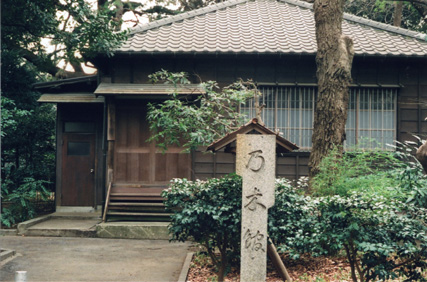
In the spring break of 2002, I waged my first try to go for a stroll in the gakushuin (学習院)campus, an unsuccessful attempt, for the seimon (正門) security officer with blue uniform could tell immediately that I was a gaijin. Raised his arms with both forearms crossed, very politely with a long story in Japanese he advised me not to get in, lots of a-no, de and ne sounds, bowing with a regrettable facial expression, and I bowed back, with smile, a natural kind of course. Perhaps I should have hung my M-4 with Summicron 35mm/f 2.0―things might just have changed a bit. Never-the-less, today, Jan. 24, 2007, I did break through the blockage under the covering of a pride of handsome gakushuin students coming out of the mejiro eki, stepping through the west gate.
I came to Tokyo in 2002 to learn architectural design, or, to steal a parchment kind of paper more likely, and, with a true intention to satisfy my curiosities long embedded in my skull since childhood. Because of the Japanese colonization, my parents both speak Japanese and do so even today. Perhaps at 10, I vaguely remember, my uncle, my mother side, was sent by the bank he worked in Taipei for a shucchou (出張) to Tokyo in the 60s when Taiwan had been under severe marshal law. Japanese movies, for instances, were banned in the 70s and 80s, traveling abroad was a hard issue with lots of governmental paperwork. He came back with a Toshiba rice-cooker with a transparent plastic concave right beneath the handle of the rice-cooker cover, a Nikon camera with trace of Contax IIIa and a Yashica with rolleiflex look. They did make tasty rice and good photos. Also, Kobayashi Akira was my hero, saving cute girls from beating up nasty guys. As my brain got grown sophistically, somehow I had an impression that the Japanese sense of beauty, quite often, seemed to go hand in hand with sorrow. The Zengakuren(全学連)chaos, for instance, between the armed police force and the students wearing big white mouth-muffle in Toudai had been aired in the then Taiwan TV, followed by Mishima Yukio's final episode in the end of 1970, and, in 1973, as I was struggling to get some college education, my ears had been stuffed with a ceaseless talking topic among my parents and their friends―that Yoshinaga Sayuri married a 40-year-old-n-funny Fuji TV director, and last but not the least, he was a second-hand bachelor. "She should at least marry a medical doctor," said my mother. That "it is unfair" was thus their conclusion. My heart sunk as well; despite of my dumb puberty age I can sense the sorrowfulness accompanying with regret. O.K. Enough! Switch channel to the gakushuin topic.
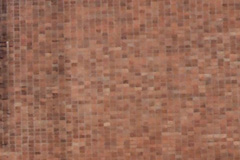
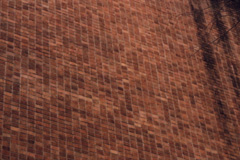
Why did I in March 2002 wish to see gakushuin? There are 2 reasons. First, I was at my first glance impressed with the style of the gakushuin seimon. It seems that an institutional Japanese building complex usually has the seimon designed to express her identity. My favorite seimon design is of the Toudai komaba. Stepping out of the inogashira densha gate, I faced the seimon immediately and got reminded of the Japanese Imperial House by the pair of huge heavy wood-built wall-like door with the engraved chrysanthemum patterns, which projects a touch of the Japanese sense of sublime mixed with elegance. The Akamon gate in Hongou magnets me to step through with the same power as well. Gakushuin's old brick buildings seem to share the same style with her counterparts in Toudai. The scraped stone walls of the rigakubu, I wonder, were done by the same drama carried out by the Zengakuren who contributed the scraped stone walls of the Yasudakoudou. Also, the dark-red brick walls of the old buildings somehow evoked my admiration of the aging brick buildings of the Cambridge University, England, particularly that of the Queen's College. Arguably though, the white pyramid-like lecture hall is perhaps a bit too eye-catching to suit her surrounding brick buildings.
My second reason was personal, that Mishima Yukio graduated from the gakushuin koutouka. Threading through the building complex down to the south area, excitingly, I saw the horse riding society established in 1878 right below the back slope of Nogikan, a residence for the then gakushuin principal Nogi Maresuke(1906-12). I believe he had spent his last 6 or 7 years in grief, praying peace and relief for the killed soldiers, both of the Japanese side and the Russian as well, apart from his daily duties for the gakushuin. A well-preserved washiki house without any decorative appearance except for a pair of stone tablets nearby engraved with hard-to-read kanji perhaps about his military career, surrounded by the trees planted maybe by the Marshal himself. Was this the place he and his wife committed the act to follow the Meiji Emperor? I chanted a few lines of kannon sama (観音) for the dead. A student-like skinny young man jogging through the surrounding woods, I followed his stone slab jogging path descending to the stable, a couple of good-looking boy and girl, wearing rain coat, were washing the horses; the girl was trying to wash off the dirt from the horse shoes by holding up the rear legs, yelling and slapping the rear trunk of the animal that were uncooperative. The boy chuckled out loud cheerfully. 12 horses were there altogether. Perhaps a hundred years ago the cavalry cadets were trained here; yet today it reminds me of the story narrated in the novel 優駿 by Miyamoto Teru and of the TV drama aired last year, a romantic story about a young girl. Again, a teen-ager girl with innocent beauty mixed with sorrowful or, perhaps melancholy personality, breeding and taking care of the racing horses in the ranch, I don't need to guess the result of that romance.
A clean and crisp campus radiating moody dignity with elegant history, Gakushuin expects her students not only to grow up with scholarly senses but to glow with noble sensibilities.
中山安兵衛はどうしてここで血刀を洗ったか:渡邊大志
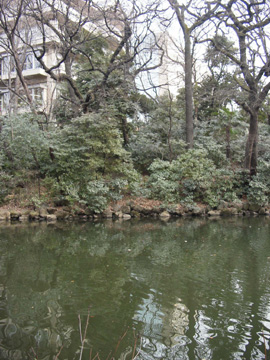
高田馬場の決闘で中山安兵衛が叔父の菅野六朗左衛門を助太刀し、村上庄衛門一派を切り捨てた後にこの池でその血刀を洗ったとされている。それ故この池は学習院大学という特別な領域にあって、「血洗いの池」という凄まじい名前を今なお留めているわけである。安兵衛が本当にここで刀を洗ったとすれば西早稲田からここまで歩いてきたわけだが、よく知られている高田馬場の決闘では安兵衛は自宅のあった五反田付近から高田馬場まで走って駆けつけている。駆けつけるなり村上一派と真剣勝負で相手を切り捨て、そのままその足で目白まで駆けつけてこの池で刀を洗った。もちろん当時はまだ学習院大学は存在しないから(1877年開校)、校門で呼び止められる事もなかっただろうが、わざわざここで血刀を洗う為に駆けつける様は滑稽である。
私達が決闘場所の西早稲田から目白まで明治通り沿いに歩いてもざっと30分程度かかった。目白通りと明治通りの交差点から学習院までもう少し歩き、ちょっと厳しい警備をやり過ごしたとしても「血洗いの池」はキャンパスの一番奥にひっそりと残っているので、ここまでたどり着くには正味一時間はかかってしまう。安兵衛がマラソン選手並みの持久力をもっていたとして走って20分程度の距離だろう。しかし、忘れてはいけない。安兵衛はすでに五反田から西早稲田まで走って駆けつけているのである!つまり安兵衛は五反田から目白までを一目散に駆け抜け、その過程でたまたますれ違った叔父の決闘に助太刀した。この体力には脱帽するばかりだ。
たまたま通りかかったというのは、そうでなければ安兵衛は六朗左衛門を助けるなりすぐさま刀を洗うべく目白を目指しただろうか。助太刀が目的であればそうではあるまい。安兵衛は六朗左衛門と語り歩きながら、すぐそばを流れている神田川などで刀を拭ったと考えるのが自然である。
当時の安兵衛が帯刀していた刀は江戸時代に一般に普及していた打刀であったと推測される。室町時代以降、刃を上向きにして腰に差す打刀(うちがたな)が刃を下向きにして腰に佩(は)く太刀に代わって普及していた。玉鋼と呼ばれる不純物の少ない鋼から水減らし、鍛錬、造り込み、仕上げ工程を経て作られた打刀は確かに耐錆性も優れていた。それでも、血には人間の油が混ざっているから普通は決闘の決着がつけばその場で刀を拭いそうなものである。当時の打刀は焼き入れの際には水で行われることが一般的であったことからも過度の油類は好まれなかったに違いない。だとすれば、どうして安兵衛は目白まで血刀をそのままにして来たのだろうか。
こうは考える事ができないだろうか。安兵衛は、始めから目白でその血刀を洗うべくとにもかくにも五反田から疾走してきた。つまり六朗左衛門を助太刀することが目的ではなかったのではないか。安兵衛にはここで血刀を洗わなければならない別の目的があったに違いない。
例えば、と想像を巡らす事から何かが始まりそうだ。「血洗いの池」で刀を拭っている安兵衛を想像すると彼が日本最大級のロングランを続けている「忠臣蔵」に登場する堀部安兵衛と同一人物だとは到底思われない滑稽さを持っている。なにしろ、刀を洗うべくわざわざ五反田から目白まで疾走しているのだから。
現在「血洗いの池」には一本の桟橋が架かっている。そこから見える池の中心には小さな噴水が湧いていて、ややもすると金の斧と銀の斧のどちらか聞かれそうなものである。演劇に喜劇と悲劇があるように、試しに落としたのは血刀ですと答えてみよう。「血洗いの池」は少し滑稽な安兵衛を教えてくれるだろう。
